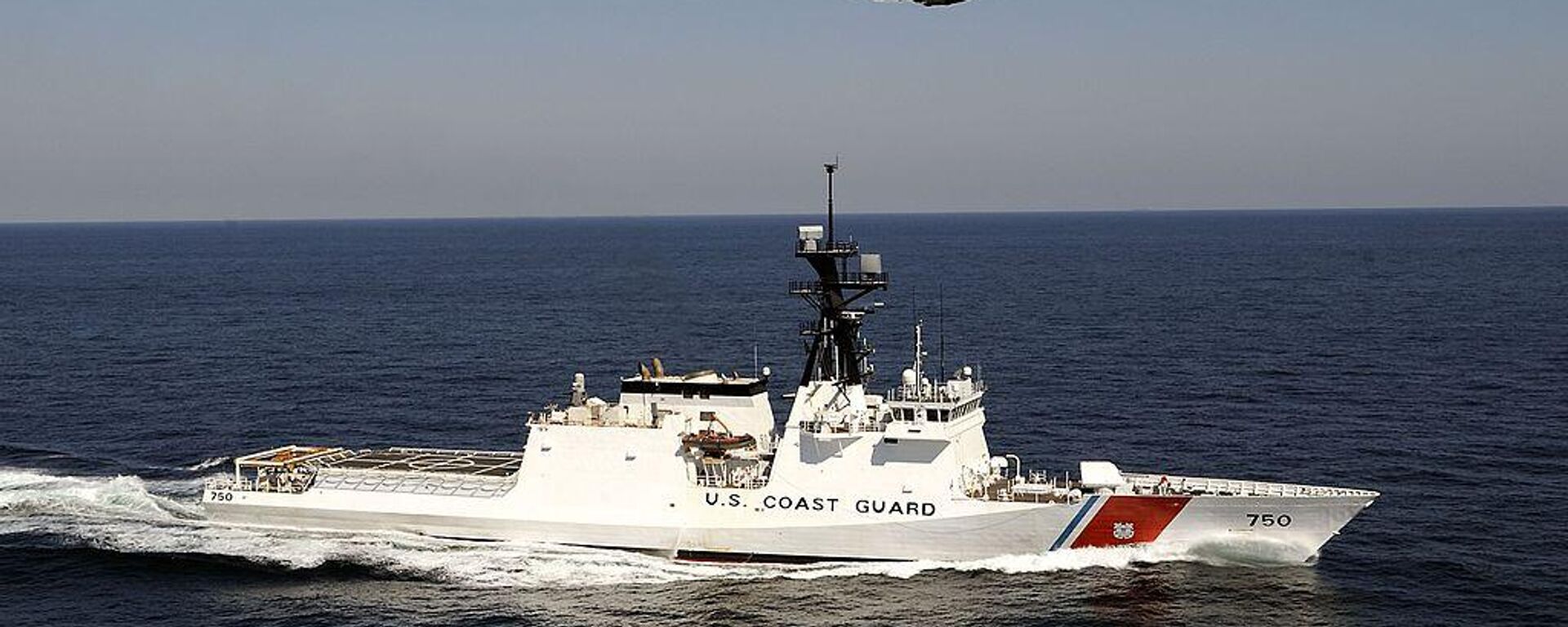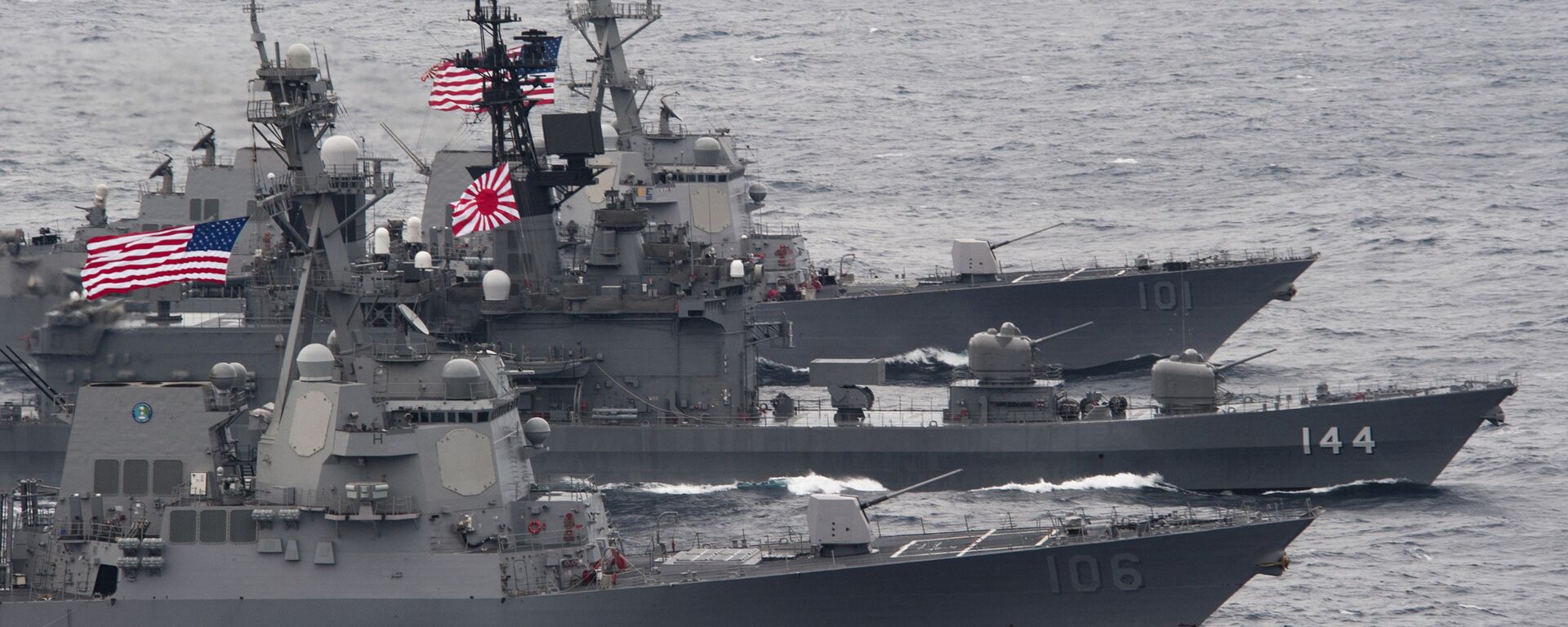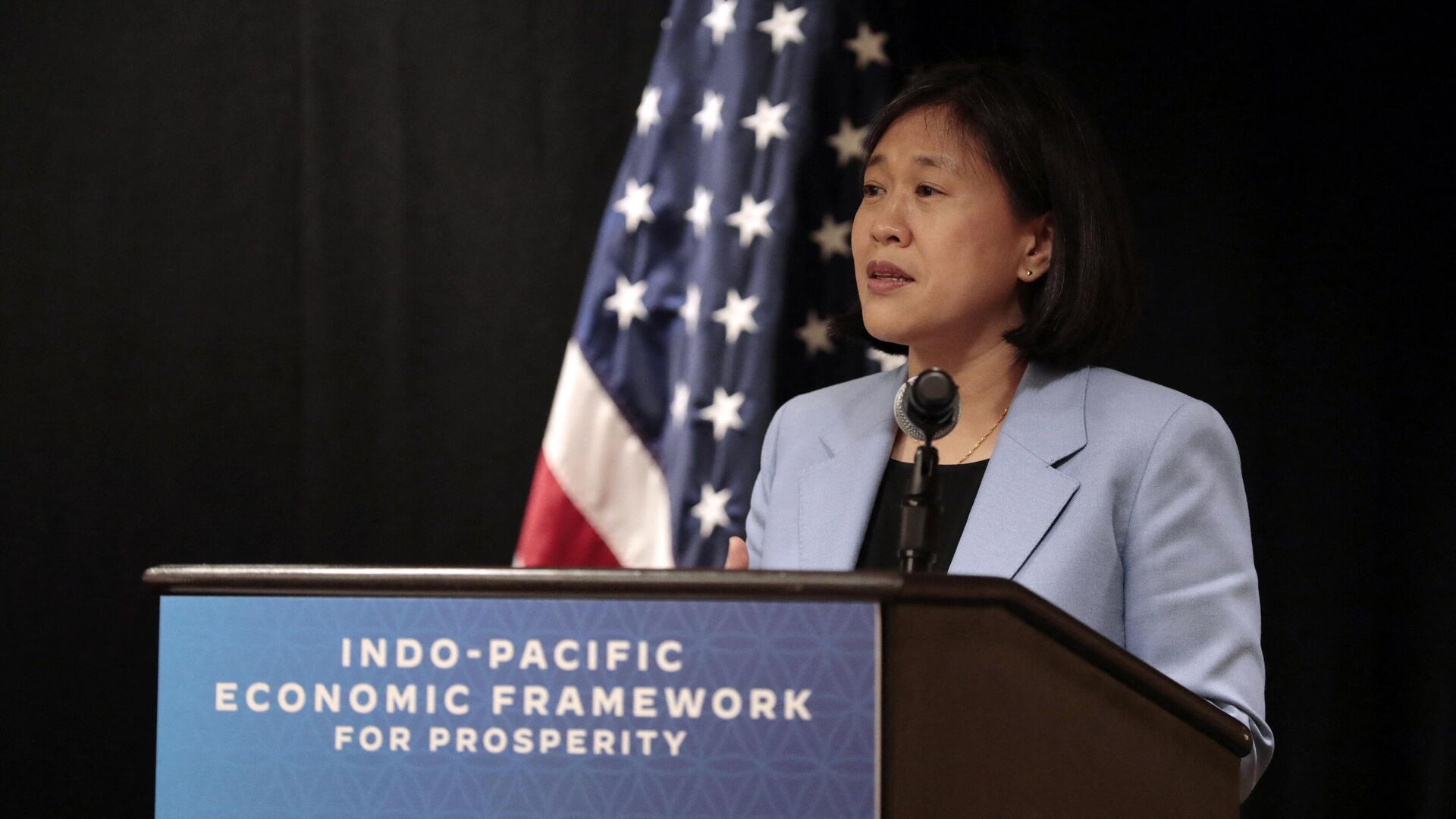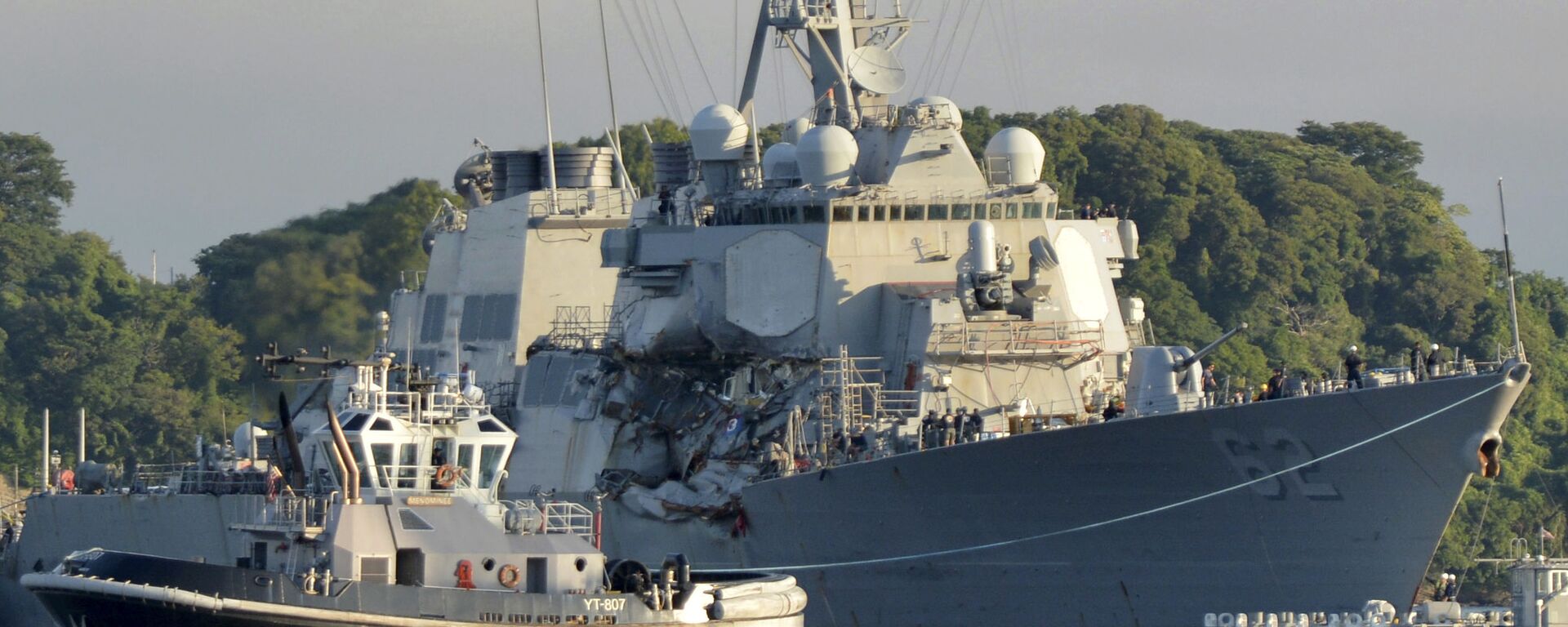https://sputnikglobe.com/20230603/us-trojan-horse-all-to-know-about-the-indo-pacific-economic-framework-1110872614.html
US’ Trojan Horse: Indo-Pacific Economic Framework Outside, So What’s Inside?
US’ Trojan Horse: Indo-Pacific Economic Framework Outside, So What’s Inside?
Sputnik International
China views the IPEF as the US-friendly structure aimed at dividing countries in the Indo-Pacific, rather than allowing them to work together to create a shared future.
2023-06-03T12:19+0000
2023-06-03T12:19+0000
2023-06-03T12:49+0000
world
us
china
framework
economy
initiative
https://cdn1.img.sputnikglobe.com/img/07e7/06/03/1110872455_0:0:3071:1728_1920x0_80_0_0_9e0dcf0e3702d509254f21b7e09801f8.jpg
Speaking at the Shangri-La Dialogue, a security conference which is held every year in Singapore by the independent International Institute for Strategic Studies think tank, US Defense Secretary Lloyd Austin claimed that Washington is not trying to create a NATO-like alliance in the Indo-Pacific region.However, this comes as the US continues to expand its clout in the region, not least through the so-called Indo-Pacific Economic Framework for Prosperity (IPEF) initiative. What is the IPEF?The IPEF is an economic initiative, which was launched by President Joe Biden in May 2022 and currently comprises 14 member states, including Australia, Brunei, Fiji, India, Indonesia, Japan, Malaysia, New Zealand, the Philippines, Singapore, South Korea, Thailand, the US, and Vietnam.According to the Office of the United States Trade Representative (USTR), “the 14 IPEF partners represent 40% of global GDP and 28% of global goods and services trade.”What are the IPEF's 'Pillars'? The framework identifies four broad “pillars”, where it intends to bolster cooperation and build synergies with member countries. They include:In its fact sheet, the White House, in turn, stressed that the IPEF “will strengthen our ties in this critical region [the Indo-Pacific] to define the coming decades for technological innovation and the global economy. Why Was the IPEF Created?Biden touted the initiative as something that is "writing the new rules for the 21st century economy," arguing that the agreement would make the participant's economies "grow faster and fairer."Shortly before the IPEF’s launch, one US news network, for its part, noted that Washington had initiated the framework “as a way to counter China’s growing influence and make up for lost ground after pulling out of previous efforts to set regional trade rules.”The media outlet added that the framework is “the most significant American economic engagement in the region” since then-US President Donald Trump pulled out of the 12-member Trans-Pacific Partnership Agreement (TPP) in 2017.Is the IPEF Already Functioning?There are some notable activities, as the framework’s member states announced “the substantial conclusion of the negotiations [in Detroit]” on an IPEF Supply Chain Agreement on the 31st of May.The document, which was touted as “a first-of-its-kind” international IPEF deal, aims “to increase the resilience and efficiency <...> of their [IPEF members] supply chains,” according to the US. The participants agreed to develop workforce development, and highlight opportunities for technical assistance and capacity building.The deal calls on member states to form a council to coordinate supply chain activities and a so-called "Crisis Response Network" to give early warnings to IPEF countries of potential supply disruptions.What is China's Stance on the IPEF? In a recent editorial, a Chinese newspaper labeled the IPEF a “Trojan horse for the US,” a “geopolitical tool of the Biden administration, which is seeking to isolate China in the region” and as “nothing more than a means to imprint the legacy stamp of ‘America first’ on the region."On the IPEF Supply Chain Agreement, the newspaper cited Chinese Foreign Ministry spokesperson Mao Ning as saying that this "discriminatory" document "ruins the open and inclusive foundation on which the Asia-Pacific region has achieved its economic success."According to Mao, “the pact is being carried out with the objective of excluding China from the regional supply chain network, and reforming that network with the US as the new hub.”This echoed last May’s remarks by Chinese Foreign Minister Wang Yi, who underscored that China, like other countries in the region, welcomes initiatives that are “conducive to strengthening regional cooperation”, but that it “opposes attempts to create division and confrontation.”Wang warned that “if the IPEF becomes a political tool for the United States to safeguard its regional economic hegemony and deliberately exclude specific countries, that would be a wrong way to go.”
https://sputnikglobe.com/20221018/us-pushes-to-expand-coast-guard-patrols-in-indo-pacific-to-hem-in-china-1102007024.html
https://sputnikglobe.com/20230522/us-aims-to-knit-up-china-in-pacific-islands-scramble-with-papua-defense-deal-1110525955.html
https://sputnikglobe.com/20230114/china-asks-us-japan-not-to-turn-asia-pacific-region-into-wrestling-ring-1106314070.html
china
Sputnik International
feedback@sputniknews.com
+74956456601
MIA „Rossiya Segodnya“
2023
Oleg Burunov
https://cdn1.img.sputnikglobe.com/img/07e4/09/0b/1080424846_0:0:2048:2048_100x100_80_0_0_3d7b461f8a98586fa3fe739930816aea.jpg
Oleg Burunov
https://cdn1.img.sputnikglobe.com/img/07e4/09/0b/1080424846_0:0:2048:2048_100x100_80_0_0_3d7b461f8a98586fa3fe739930816aea.jpg
News
en_EN
Sputnik International
feedback@sputniknews.com
+74956456601
MIA „Rossiya Segodnya“
Sputnik International
feedback@sputniknews.com
+74956456601
MIA „Rossiya Segodnya“
Oleg Burunov
https://cdn1.img.sputnikglobe.com/img/07e4/09/0b/1080424846_0:0:2048:2048_100x100_80_0_0_3d7b461f8a98586fa3fe739930816aea.jpg
indo-pacific economic framework, ipef initiative, ipef launch, ipef framework, indo-pacific region, china's stance on ipef
indo-pacific economic framework, ipef initiative, ipef launch, ipef framework, indo-pacific region, china's stance on ipef
US’ Trojan Horse: Indo-Pacific Economic Framework Outside, So What’s Inside?
12:19 GMT 03.06.2023 (Updated: 12:49 GMT 03.06.2023) China views the IPEF as a US-friendly structure aimed at dividing countries in the Indo-Pacific, rather than allowing them to work together to create a shared future. Why was the IPEF launched and how does it function? Sputnik explores.
Speaking at the Shangri-La Dialogue, a security conference which is held every year in Singapore by the independent International Institute for Strategic Studies think tank,
US Defense Secretary Lloyd Austin claimed that Washington is not trying to create a NATO-like alliance in the Indo-Pacific region.
However, this comes as the US continues to expand its clout in the region, not least through the so-called
Indo-Pacific Economic Framework for Prosperity (IPEF) initiative.
The IPEF is an economic initiative, which was launched by President Joe Biden in May 2022 and currently comprises 14 member states, including Australia, Brunei, Fiji, India, Indonesia, Japan, Malaysia, New Zealand, the Philippines, Singapore, South Korea, Thailand, the US, and Vietnam.

18 October 2022, 12:20 GMT
According to the Office of the United States Trade Representative (USTR), “the 14 IPEF partners represent 40% of global GDP and 28% of global goods and services trade.”
What are the IPEF's 'Pillars'?
The framework identifies four broad “pillars”, where it intends to bolster cooperation and build synergies with member countries. They include:
Clean energy, infrastructure and decarbonization
Robust taxes and anti-corruption efforts
In its fact sheet, the White House, in turn, stressed that the IPEF “will strengthen our ties in this critical region [the Indo-Pacific] to define the coming decades for technological innovation and the global economy.
Why Was the IPEF Created?
Biden touted the initiative as something that is "writing the new rules for the 21st century economy," arguing that the agreement would make the participant's economies "grow faster and fairer."
Shortly before the IPEF’s launch, one US news network, for its part, noted that Washington had initiated the framework “as a way to counter China’s growing influence and make up for lost ground after pulling out of previous efforts to set regional trade rules.”
The media outlet added that the framework is “the most significant American economic engagement in the region” since
then-US President Donald Trump pulled out of the 12-member Trans-Pacific Partnership Agreement (TPP) in 2017.
Is the IPEF Already Functioning?
There are some notable activities, as the framework’s member states announced “the substantial conclusion of the negotiations [in Detroit]” on an IPEF Supply Chain Agreement on the 31st of May.
The document, which was touted as “a first-of-its-kind” international IPEF deal, aims “to increase the resilience and efficiency <...> of their [IPEF members] supply chains,” according to the US. The participants agreed to develop workforce development, and highlight opportunities for technical assistance and capacity building.
The deal calls on member states to form a council to coordinate supply chain activities and a so-called "Crisis Response Network" to give early warnings to IPEF countries of potential supply disruptions.
What is China's Stance on the IPEF?
In a recent editorial, a Chinese newspaper labeled the IPEF a “Trojan horse for the US,” a “geopolitical tool of the Biden administration, which is seeking to isolate China in the region” and as “nothing more than a means to imprint the legacy stamp of ‘America first’ on the region."
“The IPEF is not trade liberalization. That explains why after being formed a year ago, the IPEF remains largely a talking shop. The US' attitude toward the IPEF is based on domestic politics and the need for ‘competition’ with China, rather than its common interests with the participants,” the newspaper argued, adding that the framework “goes against the law of the market,” with its “questionable value and sustainability”.
On the IPEF Supply Chain Agreement, the newspaper cited Chinese Foreign Ministry spokesperson
Mao Ning as saying that this "discriminatory" document "ruins the open and inclusive foundation on which
the Asia-Pacific region has achieved its economic success."
According to Mao, “the pact is being carried out with the objective of excluding China from the regional supply chain network, and reforming that network with the US as the new hub.”
Another Chinese news outlet has, meanwhile, quoted He Weiwen, a senior fellow at the Center for China and Globalization think tank as saying that the IPEF is “neither a trade agreement nor an economic community; it's just a framework, meaning that it will have no real efficacy.”

14 January 2023, 11:13 GMT
This echoed last May’s remarks by Chinese Foreign Minister Wang Yi, who underscored that China, like other countries in the region, welcomes initiatives that are “conducive to strengthening regional cooperation”, but that it “opposes attempts to create division and confrontation.”
Wang warned that “if the IPEF becomes a political tool for the United States to safeguard its regional economic hegemony and deliberately exclude specific countries, that would be a wrong way to go.”






